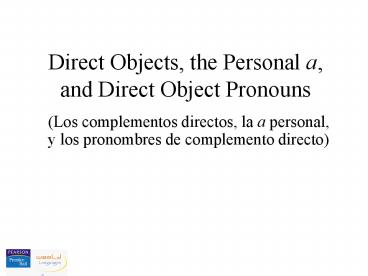Direct objects, pronouns, personal a - PowerPoint PPT Presentation
1 / 19
Title:
Direct objects, pronouns, personal a
Description:
Direct Objects, the Personal a, and Direct Object Pronouns ... Paseo a mi perro todas las ma anas. Patriots love their country. Los patriotas aman a su patria. ... – PowerPoint PPT presentation
Number of Views:661
Avg rating:3.0/5.0
Title: Direct objects, pronouns, personal a
1
Direct Objects, the Personal a, and Direct Object
Pronouns
(Los complementos directos, la a personal, y los
pronombres de complemento directo)
2
- A direct object is a thing or person that
receives the direct action of the verb.
I eat the tamales.
Yo como los tamales.
Óscar kisses his wife.
Óscar besa a su esposa.
3
- Notice that direct objects that are people or
domesticated animals (and sometimes personified
things) are signaled by the personal a.
Óscar kisses his wife.
Óscar besa a su esposa.
I walk my dog every morning.
Paseo a mi perro todas las mañanas.
Patriots love their country.
Los patriotas aman a su patria.
More information about the personal a follows on
the next slide.
4
More on the personal a
Generally, the personal a is not used after the
verb tener.
Óscar tiene una esposa muy bonita.
Óscar has a very pretty wife.
Nor is it used with a direct object that is an
unspecified or indefinite person.
Buscamos una secretaria eficiente.
Were looking for an efficient secretary.
5
More on the personal a
The personal a followed by the definite article
el contracts to form al.
Alicia visita al médico.
Alicia visits the doctor.
When the interrogative quién(es) requests
information about the direct object, the personal
a precedes it.
Whom is Elisa calling?
A quién llama Elisa?
The personal a must be repeated before each human
direct object in a series.
Visito a Emilio y a Lola.
I visit Emilio and Lola.
6
Identifying a direct object
- A direct object is a thing or person that answers
what or whom, respectively, in the following
equation
SUBJECT VERB WHAT (WHOM)
DIRECT OBJECT
Yo
como
los tamales
7
- Pronouns are particles (little words) that take
the place of the object itself, so that the
object does not have to be repeated ad nauseum .
. .
8
- Pronouns are particles (little words) that take
the place of the object itself, so that the
object does not have to be repeated ad nauseum .
. .
the piano
the piano
the piano
the piano
the piano
the piano
Notice how many times the piano was repeated.
9
- Pronouns are particles (little words) that take
the place of the object itself, so that the
object does not have to be repeated ad nauseum .
. .
A better, more concise way is to use pronouns
instead of repeating the noun over and over.
10
- Direct object pronouns in Spanish, just as in
English, take the place of the direct object
itself, so that the direct object does not have
to be repeated, and repeated, and repeated . . .
11
- The direct object pronouns in Spanish are as
follows
These are used exclusively
me
nos
te
os
These are used
lo, la
los, las
12
Now lets see how pronouns replace things or
people that are direct objects.
I eat the tamales.
Yo como los tamales.
Yo los como.
Notice that third-person direct object pronouns
agree in gender and number with the noun they
replace.
13
Now lets see how pronouns replace things or
people that are direct objects.
Óscar kisses his wife.
Óscar besa a su esposa.
Óscar la besa.
Notice that third-person direct object pronouns
agree in gender and number with the noun they
replace.
14
Notice that the personal a goes away when the
direct object noun is replaced by a direct object
pronoun.
- Óscar besa a su esposa.
Óscar la besa.
15
PLACEMENT OF PRONOUNS
ALL object pronouns are placed either before a
conjugated verb
(except for affirmative command forms)
- Óscar la besa.
(Óscar, bésala.)
or after an infinitive or gerund (present
participle).
Óscar la va a besar.
Óscar va a besarla.
Óscar la está besando.
Óscar está besándola.
16
Direct object pronouns are commonly used in
conversation when the object is established or
known. Again, this avoids needless repetition.
Dónde ves a Jorge y a Sarita?
Where do you see Jorge and Sarita?
I see them in class.
Los veo en clase.
Visitas a tu abuela con frecuencia?
Do you visit your grandmother often?
Yes, I visit her a lot.
Sí, la visito mucho.
Do not be misled into thinking that los and la in
the above answers are the subjects of the
sentences just because they appear in subject
position. The subject of both answers, which is
of course yo, is simply not expressed in these
instances.
17
Be aware that object pronouns, just like verbs,
must make a flip-flop transition when first and
second persons are involved in the conversation.
Me vas a invitar a tu fiesta?
Sí, te voy a invitar.
Nos puedes ayudar mañana?
No, no los puedo ayudar.
18
In negative sentences, the direct object pronoun
is placed between no and the conjugated verb.
Adolfo no la va a llamar.
Adolfo is not going to call her.
But, again, as in affirmative sentences, the
object pronoun may be attached to the end of the
infinitive or present participle.
Adolfo no va a llamarla.
19
FIN































